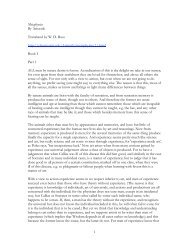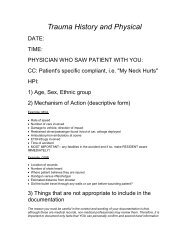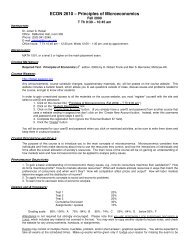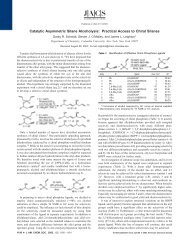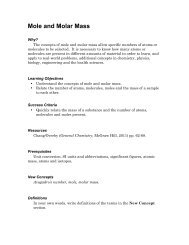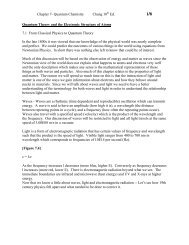Universal Health Care Is the Best Solution for Uninsured ... - PageOut
Universal Health Care Is the Best Solution for Uninsured ... - PageOut
Universal Health Care Is the Best Solution for Uninsured ... - PageOut
Create successful ePaper yourself
Turn your PDF publications into a flip-book with our unique Google optimized e-Paper software.
“<strong>Universal</strong> <strong>Health</strong> <strong>Care</strong> <strong>Is</strong> <strong>the</strong> <strong>Best</strong> <strong>Solution</strong> <strong>for</strong> <strong>Uninsured</strong> Americans”<br />
by Robert L. Ferrer<br />
In <strong>the</strong> following viewpoint, Robert L. Ferrer argues that America's lack of a national health care system has created<br />
an institutionalized system of exclusion <strong>for</strong> those too poor to af<strong>for</strong>d medical insurance. The author maintains that as<br />
this "system of no-system" becomes more firmly entrenched, <strong>the</strong> few resources locally available to poor patients will<br />
become even more fragmented and difficult to access. A universal health care system, he contends, is <strong>the</strong> only way<br />
to provide <strong>for</strong> <strong>the</strong> 39 million uninsured Americans suffering without proper health care. Robert L. Ferrer is a physician<br />
at a county hospital in San Antonio, Texas.<br />
Originally from "<strong>Universal</strong> <strong>Health</strong> <strong>Care</strong> <strong>Is</strong> <strong>the</strong> <strong>Best</strong> <strong>Solution</strong> <strong>for</strong> <strong>Uninsured</strong> Americans" by Robert L. Ferrer.<br />
<strong>Health</strong> <strong>Care</strong>. Karen Balkin, Ed. Opposing Viewpoints Series. Greenhaven Press, 2004. Robert L. Ferrer,<br />
"Within <strong>the</strong> System of No-System (A Piece of My Mind)," JAMA, The Journal of <strong>the</strong><br />
American Medical Association, November 28, 2001, pp. 2,513-15.<br />
My waiting room is bigger than yours. It seats 228 and by mid-afternoon it is usually packed. On a good<br />
day patients will wait two to three hours to see me or one of <strong>the</strong> o<strong>the</strong>r clinicians who work here. On a bad<br />
day <strong>the</strong> wait can reach five or six hours. Not as many patients complain as you might think. Almost all are<br />
uninsured, and <strong>the</strong>y have nowhere else to go. Our "acute care" clinic is a large county-hospital walk-in<br />
clinic—<strong>the</strong> portal of entry to <strong>the</strong> public health care system in a county in which 360,000 of <strong>the</strong> 1.3 million<br />
inhabitants are uninsured. The numbers are alarming, but <strong>the</strong> stories underlying <strong>the</strong>m are even worse.<br />
The <strong>Uninsured</strong> Suffer Most<br />
* A woman with flank pain, dysuria, and a temperature of 103 who had been seen in a local emergency<br />
department (ED) <strong>the</strong> previous night. She was given some type of injection <strong>for</strong> pain and sent home. No<br />
tests had been done. Results of urinalysis done in our office confirmed pyelonephritis.<br />
* A man with a sore throat who had spent <strong>the</strong> previous night in our hospital's ED and left after waiting<br />
more than 16 hours to be seen. He had a peritonsillar abscess and needed <strong>the</strong> care of an<br />
otolaryngologist, so we sent him back to <strong>the</strong> ED. This time he went with a diagnosis.<br />
* A man who said that his cardiologist sent him to our clinic <strong>for</strong> "blood pressure medication and<br />
a pacemaker." He had fainted during a recent treadmill examination at <strong>the</strong> cardiologist's office. He <strong>the</strong>n<br />
lost his health insurance and could no longer be seen <strong>the</strong>re.<br />
* A man with a large bandage on his hand. Three days earlier, <strong>the</strong> fourth and fifth fingers of his left hand<br />
had been amputated in a chain saw accident and <strong>the</strong>n reattached at ano<strong>the</strong>r hospital. Because he had no<br />
insurance, he was sent to our walk-in clinic <strong>for</strong> follow-up.<br />
* A child sent home from school two weeks earlier with "pink eye." The child's school administration would<br />
not readmit her without a doctor's note, and her parents needed two weeks to ga<strong>the</strong>r <strong>the</strong> money <strong>for</strong> a<br />
doctor visit so <strong>the</strong>y could obtain <strong>the</strong> necessary note.<br />
* A 22-year-old man with dyspnea, a heart rate of 160, and a large globular heart on his chest film. He<br />
came to see us instead of his "usual" physician because he had recently lost his job and his health<br />
insurance because of frequent medical absences caused by his lupus.<br />
* A middle-aged man with severe shoulder pain and a ruptured short head of his biceps. The consultant<br />
refused to see him on an expedited basis, explaining, "These people get free care; <strong>the</strong>y should expect to<br />
wait."<br />
* A homeless man who is a heavy drinker with arm pain. He had been seen several weeks earlier at an<br />
ED <strong>for</strong> <strong>the</strong> same problem and released without treatment. His humerus was grossly angulated, and a<br />
fracture was evident on x-ray. Examination of his head revealed a large depressed skull fracture.<br />
1
* An HIV-negative man with fever, cough, weight loss, and Mycobacterium kansasii growing from his<br />
sputum. He had been seen in <strong>the</strong> county tuberculosis (TB) clinic but was discharged six months earlier<br />
when his culture was reported as not Mycobacterium tuberculosis. He was told to "see a doctor."<br />
* A man in his early 20s with a worsening dental infection who was unable to af<strong>for</strong>d a dentist. He finally<br />
saw a physician who prescribed an antibiotic, but <strong>the</strong> patient was unable to pay <strong>for</strong> <strong>the</strong> prescription. He<br />
presented to our clinic with sepsis and spread of <strong>the</strong> infection to his mediastinum. He died soon after<br />
admission.<br />
I wish this was a top-ten list of lamentable stories, but it is not. The egregious is commonplace in our<br />
setting. My colleagues and I are part of what is widely known as <strong>the</strong> health care "safety net" <strong>for</strong> <strong>the</strong><br />
uninsured, but to work here is to realize that, <strong>for</strong> many, <strong>the</strong> safety net does not provide a soft landing, nor<br />
are its failures <strong>the</strong> random "accidents" implied by <strong>the</strong> image of missing a net.<br />
In actuality, events such as <strong>the</strong>se are <strong>the</strong> product of a system, an increasingly coherent system of<br />
exclusion that denies care to <strong>the</strong> uninsured: <strong>the</strong> system of no-system. The system of no-system's<br />
components are <strong>the</strong> fragmented resources locally available to <strong>the</strong> uninsured, embedded within <strong>the</strong><br />
national nonsystem of health care. It is a ne<strong>the</strong>rworld of closed doors and shrinking services.<br />
The paradox of <strong>the</strong> system of no-system is that it is becoming increasingly systematized. Unintended<br />
consequences of changes in health care organization and financing, positive feedback loops enabled by<br />
<strong>the</strong> nonsystem, and maladaptations to <strong>the</strong> health care market are solidifying <strong>the</strong> barriers to care <strong>for</strong> <strong>the</strong><br />
uninsured.<br />
Features of <strong>the</strong> System of No-System<br />
* Inversion. In <strong>the</strong> system of no-system, <strong>the</strong> relationship between needs and resources is inverted.<br />
Services are least available to those who need <strong>the</strong>m most, a situation aptly named <strong>the</strong> "inverse care law"<br />
in 1971 by <strong>the</strong> English general practitioner Julian Tudor Hart. As Tudor Hart pointed out, <strong>the</strong> inverse care<br />
law is exacerbated by a market distribution of medical care because poor people suffer <strong>the</strong> highest levels<br />
of disease and distress but offer <strong>the</strong> least financial incentive <strong>for</strong> services. Thirty years later <strong>the</strong> inverse<br />
care law still prevails, implacably en<strong>for</strong>ced by <strong>the</strong> system of no-system.<br />
* Concentration. When medicine was a cottage industry, <strong>the</strong> uninsured faced many barriers, but individual<br />
physicians could choose to provide pro bono care on a small scale, and, in <strong>the</strong> aggregate, <strong>the</strong> number<br />
of uninsured served this way was quite sizable. Now that we are well into medicine's new economic<br />
revolution, <strong>the</strong> pressure <strong>for</strong> profitability in many large systems of care is closing <strong>the</strong> doors on <strong>the</strong><br />
uninsured and concentrating <strong>the</strong>m in public facilities.<br />
* Fragmentation. With a shrinking public sector and a disinterested market, identifying sources <strong>for</strong> a<br />
comprehensive range of services has become considerably more difficult. For example, except<br />
<strong>for</strong> patients with acute psychosis or suicidal intent, obtaining timely mental health services is nearly<br />
impossible in many publicly funded health care settings.<br />
* Evasion. Despite legislation to prohibit patient " dumping," it still occurs. To survive, it has mutated into a<br />
less visible <strong>for</strong>m. Private hospitals are no longer shipping indigent patients off to public EDs in a taxicab.<br />
Instead, <strong>the</strong>y now offer perfunctory treatment, <strong>for</strong>ego any diagnostic procedures, and discharge patients<br />
with instructions to "follow up tomorrow with your primary care physician." They might as well be advised<br />
to see <strong>the</strong>ir personal banker.<br />
* Degradation. The inverse care law is not invisible to <strong>the</strong> uninsured. The system of no-system exposes<br />
patients to a number of transactions <strong>for</strong> which <strong>the</strong> price <strong>the</strong>y pay is <strong>the</strong>ir own dignity, such as being turned<br />
away when <strong>the</strong>y cannot pay in advance <strong>for</strong> services, waiting interminable hours <strong>for</strong> care, and coping with<br />
clinicians and staff who show <strong>the</strong>m little respect. In overwhelmed systems, <strong>the</strong> people served become <strong>the</strong><br />
problem.<br />
2
It would be easy <strong>for</strong> our patients to conclude that <strong>the</strong>y are worth something only as potential research<br />
subjects. The bulletin boards of our office feature equal numbers of flyers encouraging us to refer<br />
subjects <strong>for</strong> various studies and offering regrets that due to cutbacks or increased patient load, certain<br />
clinics will no longer accept new patients.<br />
* Resignation. Working within such a system slowly erodes professional standards, as clinicians yield<br />
principles to realities. What is practiced is <strong>the</strong> art of <strong>the</strong> minimal.<br />
* Amplification. <strong>Health</strong>y systems maintain stability through self-correction: threats to <strong>the</strong> system's integrity<br />
activate compensatory mechanisms that restore stability. In unhealthy systems, disturbances may trigger<br />
a response that creates an even larger disturbance: an amplification loop in which things go from bad to<br />
worse. An example is <strong>the</strong> loop enabled by employer-based health care when an employee becomes<br />
seriously ill and is fired, thus losing his health insurance, and his access to medical care. COBRA<br />
[Consolidated Omnibus Budget Reconciliation Act] medical care protection is a mirage <strong>for</strong> <strong>the</strong> working<br />
poor, with an annual cost per family of more than $7000. And those in most jeopardy <strong>for</strong> being fired<br />
because of sick time are at <strong>the</strong> lower end of <strong>the</strong> socioeconomic spectrum, thus creating a synergy<br />
between <strong>the</strong> greatest risk and <strong>the</strong> greatest consequences. A similar dysfunctional response occurs when,<br />
as <strong>the</strong> cost of health care rises, employers take steps to reduce <strong>the</strong>ir medical costs, one of which is hiring<br />
more temporary workers not covered by medical insurance. These workers are disproportionately<br />
from low-income groups and are thus less able than o<strong>the</strong>rs in <strong>the</strong> population to cope with rising health<br />
care costs.<br />
The most important example of how problems are amplified in <strong>the</strong> system of no-system is seen in <strong>the</strong><br />
public health care infrastructure, which is being stretched thinner and thinner, essentially being pulled<br />
apart by increasing numbers of uninsured on one side and falling revenues on <strong>the</strong> o<strong>the</strong>r. A vicious circle<br />
ensues of falling revenues leading to cutbacks in levels of service, driving insured patients to o<strong>the</strong>r<br />
facilities, causing a fur<strong>the</strong>r fall in revenues. Medicaid managed care has been successful in<br />
mainstreaming patients to community health care providers, but with an unintended consequence of<br />
choking off one of <strong>the</strong> main sources of income <strong>for</strong> public facilities.<br />
* Maladaptation. The system of no-system does not exist in a vacuum. It is embedded within <strong>the</strong> health<br />
care market and society at large. As those responsible <strong>for</strong> providing services within <strong>the</strong> system of nosystem<br />
cope with <strong>the</strong>se larger structures, maladaptations ensue. Some of <strong>the</strong> maladaptations result from<br />
attempting to maintain services modeled after <strong>the</strong> mainstream market without sufficient resources or<br />
personnel. O<strong>the</strong>rs arise when public institutions' strategies to survive in <strong>the</strong> market distort <strong>the</strong> decisions<br />
about what services should be pursued, leading to <strong>the</strong> paradox of high-tech citadels in Third World-like<br />
communities.<br />
Time to Rescue <strong>the</strong> <strong>Uninsured</strong><br />
In 1996, <strong>the</strong> Bulk Challenge, a leaky freighter with 4000 Liberian civil war refugees aboard, sailed along<br />
<strong>the</strong> coast of West Africa <strong>for</strong> nine days seeking a port while neighboring countries, already overrun with<br />
refugees, refused to accept <strong>the</strong> ship. The vessel had one toilet and little food or water on board. There<br />
was an outbreak of dysentery and people began to die. At <strong>the</strong> time, I remember thinking that <strong>for</strong> a cost<br />
equivalent to one MRI, one could save hundreds of lives on that boat. We are now in an analogous<br />
situation with <strong>the</strong> uninsured in <strong>the</strong> United States. The boat is overcrowded and leaky, and people are<br />
suffering <strong>for</strong> want of services.<br />
It is time to rescue <strong>the</strong> 39 million Americans who are <strong>for</strong>ced to seek care within <strong>the</strong> system of no-system.<br />
If <strong>the</strong>re is to be universal health care, we cannot keep having <strong>the</strong> same dialogues about <strong>the</strong> government<br />
vs. <strong>the</strong> market, equality vs. liberty, efficiency vs. bureaucracy. Stripped of all <strong>the</strong> ideology,<br />
<strong>the</strong> need and <strong>the</strong> suffering are <strong>the</strong>re, now, plain <strong>for</strong> all to see. Stop by my waiting room sometime and I'll<br />
show you.<br />
------------------------------------------------------------------------------------------------------------------------------<br />
3





